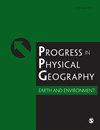全新世早期青藏高原腹地史前人类的居住与适应
IF 3.6
3区 地球科学
Q2 GEOGRAPHY, PHYSICAL
Progress in Physical Geography-Earth and Environment
Pub Date : 2023-08-24
DOI:10.1177/03091333231197168
引用次数: 0
摘要
史前人类在青藏高原的占领过程和生存策略是了解人类适应极端高海拔环境的重要科学问题。本文报道了在中东部高原通天河流域代渠(DQ)新发现的一处微石器遗址。我们从DQ遗址收集了239件石器文物进行类型学分析。OSL和AMS14C定年样品采集自人类活动层。分析了炉膛沉积物中的脂质残留物,并模拟和评估了该地点的环境极限和路线可达性。测年结果表明,DQ遗址的稳定沉积层在10.96±0.56 ka BP左右开始形成。DQ的人类活动最早可达9271±143 cal a BP,是迄今为止在高原腹地有准确地层测年记录的最早的全新世遗址。壁炉和石器文物表明,DQ遗址是一个经常被使用的季节性狩猎营地,在那里获得了优质的石器原料,并加工了微石器。居住在这里的史前人类以非反刍陆生动物为食物来源。DQ遗址的地理位置非常理想,可以作为狩猎采集者在高海拔和低海拔之间迁徙的中转站。全新世气候的改善促进了史前人类对环境极端地区的探索。本文章由计算机程序翻译,如有差异,请以英文原文为准。
Prehistoric human occupation and adaptation on the hinterland of the Tibetan Plateau in the Early Holocene
The occupation process and survival strategies of prehistoric humans on the Tibetan Plateau are important scientific questions for understanding human adaptation to extreme high-altitude environments. Here, we report a newly discovered microlithic site at Daiqu (DQ) in the Tongtian River basin of the central-eastern plateau. We collected 239 lithic artifacts from the DQ site for typological analysis. OSL and AMS14C dating samples were collected from the human active layer. Lipid residues from hearth sediments were analyzed, and we simulated and assessed environmental extremity and route accessibility for the site. Dating results suggest that the stable sedimentary layers began to form around 10.96 ± 0.56 ka BP at the DQ site. Human activity at DQ as early as 9271 ± 143 cal a BP, making it the earliest reported Holocene site with accurate stratigraphic dating on the plateau hinterland to date. Hearths and lithic artifacts indicate that the DQ site was a frequently used seasonal hunting camp, where quality lithic raw material was obtained and microliths processed. Prehistoric humans occupying the site relied on non-ruminant terrestrial animals as food resources. The DQ site is ideally situated to serve as a transit station for hunter-gatherers as they migrated between high and low elevations. Ameliorating Holocene climate promoted prehistoric human exploration of more environmentally extreme areas.
求助全文
通过发布文献求助,成功后即可免费获取论文全文。
去求助
来源期刊
CiteScore
7.20
自引率
5.10%
发文量
53
审稿时长
>12 weeks
期刊介绍:
Progress in Physical Geography is a peer-reviewed, international journal, encompassing an interdisciplinary approach incorporating the latest developments and debates within Physical Geography and interrelated fields across the Earth, Biological and Ecological System Sciences.

 求助内容:
求助内容: 应助结果提醒方式:
应助结果提醒方式:


